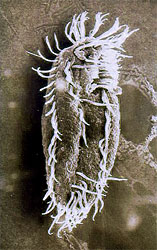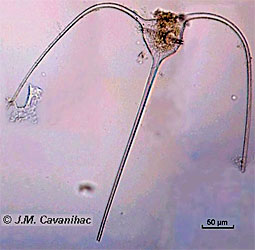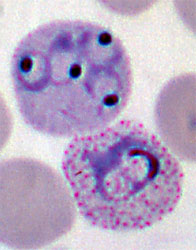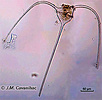Alveolates
Mitchell L. Sogin and David J. Patterson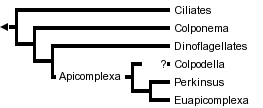


This tree diagram shows the relationships between several groups of organisms.
The root of the current tree connects the organisms featured in this tree to their containing group and the rest of the Tree of Life. The basal branching point in the tree represents the ancestor of the other groups in the tree. This ancestor diversified over time into several descendent subgroups, which are represented as internal nodes and terminal taxa to the right.

You can click on the root to travel down the Tree of Life all the way to the root of all Life, and you can click on the names of descendent subgroups to travel up the Tree of Life all the way to individual species.
For more information on ToL tree formatting, please see Interpreting the Tree or Classification. To learn more about phylogenetic trees, please visit our Phylogenetic Biology pages.
close boxIntroduction
This group of protists was hypothesized only relatively recently, and confirmed by molecular studies by Gajadhar et al. (1991). The taxon contains three major taxa with very different adaptive strategies - the flagellated dinoflagellates, the almost completely parasitic apicomplexa, and the ciliated ciliates. The relationships among the major lines of alveolates is still to be resolved as is the sister group relationship of this territory.
Characteristics
Tubulocristate protists with the cell surface underlain by a series of abutting sacs or alveoli - or derived from such organisms.
References
Gajadhar, A.A., Marquardt, W.C., Hall, R., Gunderson, J., Carmona, E.V.A. and Sogin, M.L. (1991): Ribosomal RNA sequences of Sarcocystis muris, Theileria annulata, and Crypthecodinium cohnii.reveal evolutionary relationships among apicomplexans, dinoflagellates, and ciliates. Mol. and Biochem. Parasit. 45:147-154.
Harper, J. T. and P. J. Keeling. 2003. Nucleus-encoded, plastid-targeted glyceraldehyde-3-phosphate dehydrogenase (GAPDH) indicates a single origin for chromalveolate plastids. Mol. Biol. Evol. 20:1730-1735.
Leander, B. S. and P. J. Keeling. 2003. Morphostasis in alveolate evolution. Trends in Ecology and Evolution 18(8):395-402.
Leander, B. S. and P. J. Keeling. 2004. Early evolution of dinoflagellates and apicomplexans inferred from HSP90 and actin phylogeny. J. Phycol. 40:341-250.
Patron, N. J., M. B. Rogers, and P. J. Keeling. 2004. Gene replacement of fructose-1,6-bisphophate aldolase supports the hypothesis of a single photosynthetic ancestor of chromalveolates. Eukaryotic Cell 3:1169-1174.
Information on the Internet
- Introduction to the Alveolates. UCMP Berkeley.
- Ciliate Resource Archive. Denis Lynn, University of Guelph.
- Using Ciliates in the Classroom. Dean Fraga, College of Wooster.
- DINOFLAJ: Dinoflagellate Classification Database. Rob Fensome, Andrew MacRae, and Graham Williams, Natural Resources Canada.
- Dinoflagellates. Andrew MacRae, University of Calgary.
- Welcome to the Fascinating World of Phylum Dinoflagellata. University of Miami.
- Growing dinoflagellates at home. The Bioluminescence Web Page.
Title Illustrations
| Scientific Name | Stylonychia (Ciliates) |
|---|---|
| Comments | Scanning electron micrograph |
| Specimen Condition | Dead Specimen |
| Copyright | © BIODIDAC |
| Scientific Name | Ceratium (Dinoflagellates) |
|---|---|
| Acknowledgements | Image courtesy BIODIDAC |
| Copyright | © J. M. Cavanihac |
| Scientific Name | Plasmodium vivax (Euapicomplexa) |
|---|---|
| Comments | micrograph depicting a red blood cell containing four Plasmodium vivax rings, next to a growing trophozoite |
| Creator | CDC/Dr. Mae Melvin |
| Acknowledgements | photo courtesy Public Health Image Library |
| Specimen Condition | Dead Specimen |
| Life Cycle Stage | trophozoite |
About This Page
Mitchell L. Sogin
sogin@mbl.edu
The Josephine Bay Paul Center in Comparative Molecular Biology and Evolution
Marine Biological Laboratory
7 MBL Street
Woods Hole, Massachusetts 02543
USA
David J. Patterson
dpatterson@mbl.edu
The Josephine Bay Paul Center in Comparative Molecular Biology and Evolution
Marine Biological Laboratory
7 MBL Street
Woods Hole, Massachusetts 02543
USA
Page copyright © 1995 Mitchell L. Sogin and David J. Patterson





